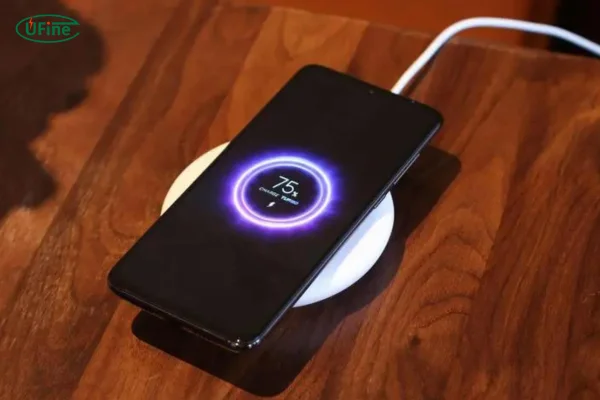
- Part 1. What is slow charge? How to define it
- Part 2. Is it better to charge the battery faster?
- Part 3. How do I know If I am slow charging my battery?
- Part 4. Does slow charging prolong battery life?
- Part 5. Does slow charging damage the battery?
- Part 6. Advantages and disadvantages of slow charging
- Part 7. How to slow charge a lithium-ion battery?
- Part 8. Slow charge battery charger
- Part 9. The best way to charge your battery
- Part 10. Conclusion
Part 1. What is slow charge? How to define it
Slow charging refers to a method of charging a battery at a lower, more gradual rate of current, which typically takes longer compared to fast charging. This is often defined by charging at a rate that is less than the maximum charge rate that the battery can handle. For instance, if a battery has a capacity of 2,000mAh, charging it at a rate of 500mA (0.25C) is considered slow charging.
This slow method contrasts sharply with fast charging, where the battery is charged at a high current rate—often 1A or more—allowing for rapid recharging but at the cost of generating more heat and stressing the battery’s components. In simple terms, slow charging is charging your battery at a pace that gives it time to safely absorb power without risk of overheating or damage.
LiPo Battery Charge Rate Calculator
Part 2. Is it better to charge the battery faster?
At first glance, it may seem obvious that faster charging would always be better—after all, who doesn’t want their device charged in record time? But, when it comes to lithium-ion batteries, faster is not always better.
While fast charging is convenient, it generates more heat. And heat is one of the biggest enemies of lithium-ion batteries. Excessive heat can cause chemical reactions within the battery that degrade the battery’s internal components. Over time, repeated fast charging can result in reduced battery capacity, lower efficiency, and in extreme cases, even swelling or leakage of the battery.
This is why, although fast charging offers the benefit of time efficiency, it accelerates battery degradation. On the other hand, slow charging, while more time-consuming, creates less heat and results in a more stable, longer-lasting battery.
Part 3. How do I know If I am slow charging my battery?
Knowing whether you’re slow charging your battery depends on a few key indicators. Here are the most straightforward ways to determine if you’re charging your device at a slow rate:
- Check the Charger’s Output: The first and easiest step is to look at the output of the charger you’re using. Slow charging typically involves using a charger with a lower current output—usually 0.5A to 1A for most devices. Chargers that supply higher current (1.5A to 2A or more) are typically fast chargers. You can check the specifications on the charger or use a multimeter to measure the output current.
- Observe the Charging Time: If your battery is taking longer than usual to charge, you’re likely slow charging. For example, if your device takes several hours to go from 0% to 100%, it’s a good sign that the charging current is slower than usual. On the other hand, if your device is fully charged in under an hour, you might be using a fast charger.
- Battery Percentage Increase Rate: Monitor how quickly the battery percentage rises when plugged in. With slow charging, the battery will increase more gradually. If you see a rapid increase in the percentage, it’s probably due to fast charging.
- Use a Battery Monitoring App: Some apps can give you real-time data on your battery’s charge rate. These apps can show the current (in amperes) being delivered to your device, so you’ll know if it’s a slow or fast charging process.
- Device Charging Settings: Many modern devices allow you to select charging modes in the settings. If your phone or laptop has a “slow charge” or “battery care” feature, enabling it will automatically throttle the charging speed, ensuring that you’re slow charging your device.
If you notice that your device is charging at a slower pace and not generating excessive heat, then you can be confident that you are slow charging. This method not only helps your battery last longer but also ensures safer charging over time.
Fast Charging vs Slow Charging: Which is Better for your Lithium Battery?
Part 4. Does slow charging prolong battery life?
Yes, slow charging does help prolong battery life. To understand why, it’s important to understand what causes lithium-ion batteries to degrade in the first place. Batteries degrade primarily due to the stresses placed on them during charging. Fast charging results in heat buildup, and heat causes chemical reactions inside the battery that slowly erode its capacity.
Slow charging, however, is much gentler on the battery. By charging the battery at a slower rate, you reduce the heat generated during the charging process. This gives the battery time to absorb the energy more efficiently, resulting in less strain and less degradation over time.
In other words, while fast charging might save time, slow charging is a more sustainable and health-conscious approach that helps preserve your battery’s capacity and extends its lifespan.
Part 5. Does slow charging damage the battery?
Surprisingly, slow charging does not damage the battery. In fact, it’s one of the safest ways to charge your lithium-ion battery. When done properly, slow charging can significantly extend the battery’s lifespan by minimizing the amount of heat generated during the charging process.
The misconception that slow charging could harm the battery might arise from the belief that if a battery takes longer to charge, it may suffer from some sort of inefficient energy transfer. However, this is not the case. Slow charging uses a lower current, allowing the battery to absorb energy more gradually, without any undue stress or overheating.
However, it’s important to ensure you are using the correct charger. Using an incompatible charger can cause issues, even with slow charging, so it’s essential to use a charger specifically designed for your device’s battery.
Part 6. Advantages and disadvantages of slow charging
Like any method, slow charging comes with its pros and cons. Let’s take a deeper dive into both sides.
Advantages:
- Prolongs Battery Life: Slow charging reduces heat buildup, which is one of the primary causes of battery degradation. This leads to a longer lifespan.
- Less Stress on the Battery: By delivering power at a slower, more controlled rate, the battery undergoes less stress, which helps maintain its capacity over time.
- Safety: Less heat means less chance of the battery overheating or becoming damaged, reducing the risk of swelling, leakage, or even fires.
Disadvantages:
- Time-Consuming: The most obvious downside is that slow charging takes longer. Depending on the battery size and charging rate, slow charging could take hours longer than fast charging.
- Less Convenient: If you’re in a rush and need your device charged quickly, slow charging might not be an ideal choice.
- Not Always Available: Some chargers and devices are designed for quick charging, and using a slow charger might not be an option if you’re in a hurry.
Despite these drawbacks, slow charging is still regarded as one of the most effective methods to maintain battery health in the long run.
Part 7. How to slow charge a lithium-ion battery?
So, how can you slow charge a lithium-ion battery? It’s not as complicated as it sounds! Here are some straightforward steps you can follow:
-
Use a Low-Current Charger: The easiest way to slow charge is to use a charger that outputs a lower current. Many standard chargers provide a charging rate of around 1A, while fast chargers might go up to 2A or more. Simply using a charger with a lower amperage will slow down the charging process.
-
Charge When You Don’t Need to Use the Device: Slow charging is best done when the device isn’t in active use. Charging overnight is ideal because it allows the battery to absorb power slowly while you sleep.
-
Enable Battery Saving Features: Many devices now come with “battery-saving” or “slow charging” modes that allow the device to charge more slowly. If your device has this feature, take advantage of it.
-
Avoid Using Fast Chargers: If you need to slow down the charging process, don’t use fast charging options like USB-C with Power Delivery or other quick-charge technologies. Stick to regular charging methods.
Part 8. Slow charge battery charger
A slow charge battery charger is designed to provide the battery with a gentle and controlled current. These chargers typically offer lower current ratings than fast chargers, ensuring that the battery does not overheat or suffer from stress during charging. Some advanced slow chargers come with smart charging technology that automatically adjusts the current rate based on the battery’s condition.
If you want to slow charge your device, investing in a good-quality slow charger is a smart choice. Look for chargers that are compatible with your specific battery type and ensure they provide regulated, stable current to prevent damage to the battery.
Part 9. The best way to charge your battery
So, what is the best way to charge your lithium-ion battery? It’s all about balance. While slow charging is great for preserving battery health, there are a few additional practices to consider:
- Avoid Charging from 0% to 100%: It’s better for your battery’s health if you charge it when it’s around 20-30% and unplug it when it’s around 80%. This prevents the battery from undergoing the stress of a full charge cycle.
- Use a Quality Charger: Always use a charger designed for your device, and avoid cheap, third-party chargers, as they may not regulate current properly.
- Charge in a Cool Environment: Heat is a battery’s worst enemy, so avoid charging your device in hot or poorly ventilated areas.
By combining slow charging with these best practices, you’ll ensure that your battery stays healthy and works for you for years to come.
Part 10. Conclusion
Slow charging may not always be the quickest option, but it’s certainly one of the best for maintaining your lithium-ion battery’s health and longevity. By reducing heat buildup, slow charging helps extend battery life, minimizes damage, and keeps your device running smoothly for longer. So, next time you plug in your device, remember: patience isn’t just a virtue, it’s a great way to preserve your battery for the future.
Related Tags:
More Articles

Can You Really Buy Cheap Batteries Safely?
Learn the truth about cheap batteries, hidden risks, and how to find affordable yet safe lithium batteries from Ufine Battery experts.
Do Lithium Batteries Require Special Strap Downs? (Safety + Vibration Control)
Discover why lithium batteries require special strap downs to prevent vibration damage, terminal stress, and internal component issues.
Battery Strap Down Safety Tips: Preventing Vibration Damage and Terminal Stress
Follow these expert battery strap down safety tips to prevent vibration damage, terminal stress, and ensure LiFePO4 battery longevity.
How to Choose a Good 18650 Battery with Reliable Quality?
Battery quality defines performance and safety. Ufine Battery shares how to source good 18650 batteries and avoid unstable suppliers.
Can I Use a Universal Battery Strap Down on LiFePO4 Batteries? (Compatibility Guide)
Learn whether universal battery strap downs are compatible with LiFePO4 batteries, and how to install them safely for vibration control.



